If you think you’re a good writer, I’m about to make you into a great one.
Because UX writing is no easy task. You know this.
There’s mountains of information to play with and you need to become an expert on any given product quickly.
What if I told you there are UX writing best practices you can implement to speed up your writing process, make life easier, and produce better content?
There is. And that’s what I’ll be sharing with you today.
Ahead you’ll be learning 13 simple but incredibly effective practices that you’ll wish you knew sooner.
Ready? Let’s go 👊
1. Use familiar terms
You always want to speak in your customers language.
I’m not talking English, French, or German, though.
I’m talking about vocabulary, jargon, and slang.
Each customer segment is familiar with different terms within these categories.
Using language they’re comfortable with makes UX copy easier to understand and more relatable.
How can you achieve this? By first piecing together a buyer persona or several depending on how many buyer types you target.
A buyer persona looks like this:
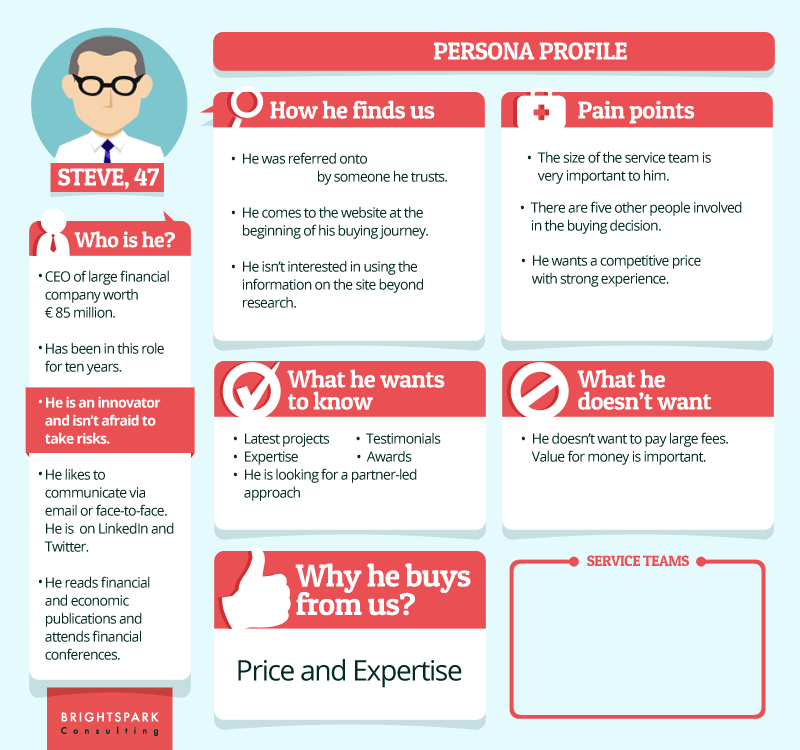
It needs to include sections such as demographics, pain points, questions, strengths, and weaknesses.
Mapping out these elements of your ideal customer is important for every aspect of marketing and advertising but especially writing.
This is because you want to clearly understand their vocabulary and reading level to craft the perfect writing style.
Which brings me to my next point.
2. Keep a positive tone
Telling a user they suck for entering a wrong password probably won’t go over too well.
That’s why positivity trumps all.

A positive tone in your UX writing will encourage users and make an app, website, or other product more enjoyable to use.
If a user feels welcomed and encouraged, that also means they will use the product for longer.
And if they do that, they remain as a customer for a longer period, refer others, etc.
It’s a small detail that can have a big payoff.
Furthermore, this is what’s called framing in neuro-linguistic programming.
Changing something to appear more positive significantly influences how a person perceives it.
3. Reduce as much as possible
We’re not writing a sales letter or landing page.
Often user experience copy pertains to help guides, popups, and other short form content.
Since you’re trying to help the user in the most optimized way possible, try considerably reducing your copy.
This means tightening up sentences, paragraphs, instructions, and other material.
If you can explain what to do in one sentence, don’t do it in four.
Isn’t it ironic this is the shortest section of the article, too? 😂
4. Simple vocabulary is key
Imagine you’re speaking to a group of Google algorithm scientists about search engines.
It’s fair to say they would know a thing or two about that, right?
Now imagine trying to explain that to a group of ten year old’s.
Both groups would require a completely different language and structure.
However, what if you could speak to both the same? Because it’s possible and much easier than you think.
You simply have to keep the vocabulary as universal as possible.
This means you should avoid technical jargon as much as possible because you’re slimming down how people overall will grasp the copy.
If you speak with simple words, everybody from the layman to the PHD student will understand.
5. Numeral values are easier to read
Numbers are much easier to scan and consume versus full words.
Sure, it’s literally a millisecond less but that can make all the difference in copywriting.
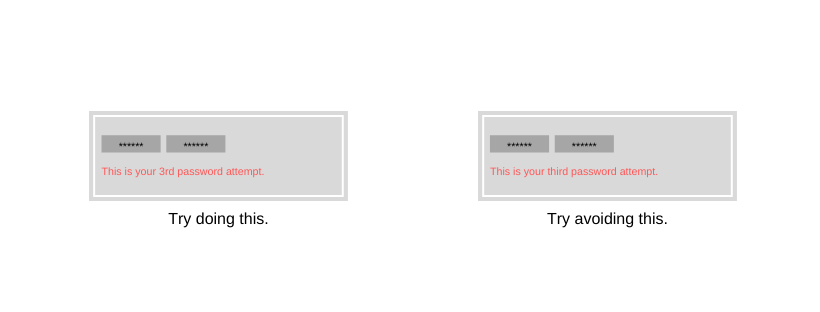
Numbers also have a powerful psychology behind them.
This is because they act as symbols just like words do.
When we see a certain number, it triggers a thought, emotion, or image.
You can use this to your advantage to make UX content more engaging and interactive.
6. Speak to the user, not about them
You want UX copy to feel personable, almost as if you’re speaking directly to the user.
This is accomplished through using first person words like “You” or “Your,” for example.
Why do you want to do this you ask? Well, take the 2016 study called Behavioral Advantages of the First-Person Perspective Model for Imitation, for instance.
Researchers studied how a first-person perspective changed how individual behaved versus a third-person one.
Astonishingly enough, the researchers found that response latency and errors decreased when using a first-person model in a series of tests.
Furthermore, participants were able to imitate movements easier when viewed from a first-person perspective.
As a UX writer, you can use these findings to improve how users engage with something by rewording everything into the first-person like such:
- Third-person: That is the wrong password.
- Person first: You entered the wrong password, please try again.
7. Use calls to action
A call to action, or CTA for short, is a word or phrase that tells the user what to do.
You’re not being grumpy or bossy by using a CTA. In fact, it’s the opposite.
A call to action helps people take the next step in achieving their goal.
That can be something as simple as signing up for an account or completing a purchase.
It reminds them of what action to take while reducing obstacles and objections.
Calls to action you can use for inspiration include:
- Sign up now
- Register today
- Buy now
- Purchase now
- Add to cart
- Add to bag
- Don’t wait
- Hurry
- Click here
- Next
- Go back
Make sure to read my guide on calls to action to learn about this strategy in-depth.
8. Leverage success and error colors
Just like words and numbers all have a deeper meaning to them, colors do, too.
For example, if you saw the color green while using an app, what do you think of?
Most likely success or you did something correctly, right?
Well, about the color red? I don’t know about you, but I instantly visualize an error that I entered the wrong email or password.
You can use colors in conjunction with UX copy to make instructions or messages stand out. These are the most common:
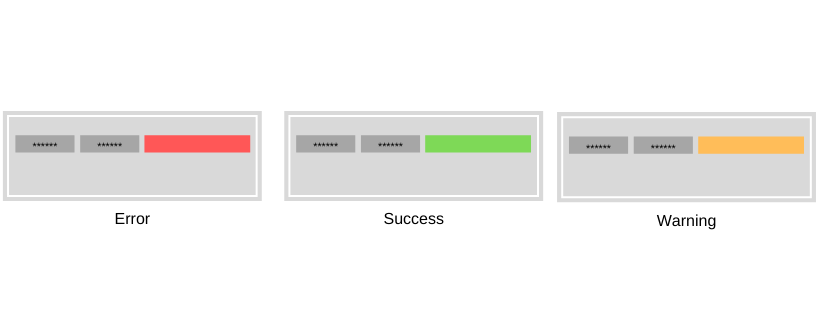
9. Keep a consistent voice
Imagine you’re the user. You click one feature and it says one thing and you click another and it has a totally different tone of voice.
That’d probably be quite confusing, right?
It’s more common than you think.
This happens when a business doesn’t have clear branding guidelines and their voice switches up like the weather.
Their team ends up speaking in a completely different voice and tone on social media, their website, and other channels.
It loses authenticity; uniqueness; character, etc.
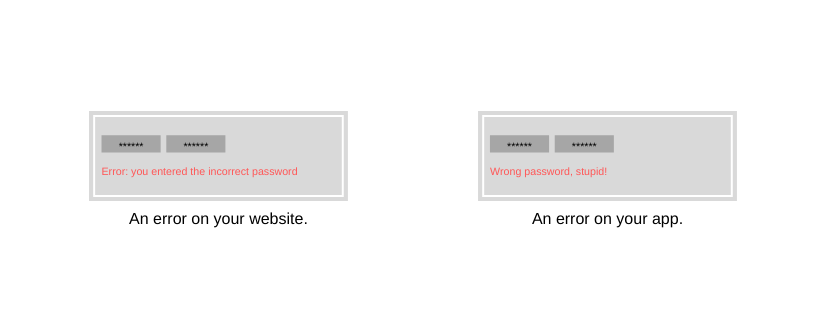
Customers will become confused and it makes your business appear unprofessional.
Let’s avoid that.
Create a document for branding guidelines that includes points like:
- What words to use and words to not use.
- A few attributes that sum up your voice like authoritative, positive, casual, etc.
- Grammar and syntax rules like using hyphens between certain words and not others, for example.
- Etc.
10. Block out distractions
Be honest with me. How many times have you checked your phone, social networks, or email today without any notifications?
That number only goes up the more notifications you get!
Precisely why another UX copywriting best practice is to knowledge what’s distracting you and swat it like a fly.
You see, your subconscious picks up on all of these little things and reacts to them whether you consciously realize it or not.
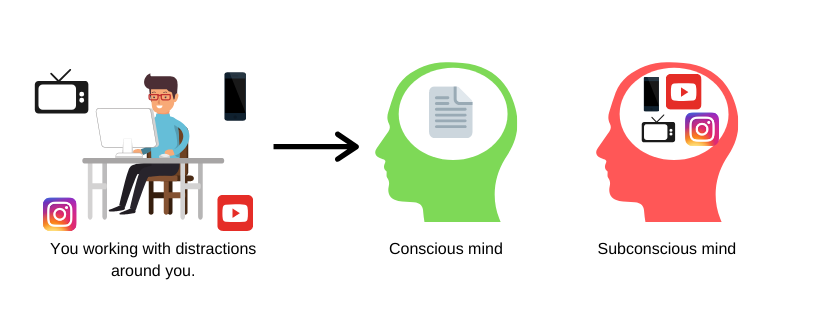
Even if you think you’re not distracted by putting your phone on silent or turning away from the TV, your brain doesn’t.
It will take up mental RAM that will reduce the focus and attention you are able to give to more impotrant tasks.
Hence why you want to have the most quiet and clear space possible.
See that empty water bottle on your desk? Go throw it out, dummy!
Is your bed messy or do you need to take out the trash? Go do it or at least make a firm commitment to do it at a specific time later.
Otherwise, these small tasks and distractions add up and eat away at the finite resource which is your mental energy.
11. Take a break from writing
Going for a walk in the sun. Grabbing a steaming cup of coffee. Reading a book.
These are all things writers like myself love and should be doing as healthy breaks.
Because the reality is writing for hours on end is not going to do you good.
In fact, it can do you bad.
Check out this study by the Behavioral and Brain Functions journal to see what I mean.
Researchers discovered that mental fatigue can be caused by an excessive cognitive load over a long period of time.
A.K.A by working for too long, you’re actually hurting your productivity.
Imagine it like this:
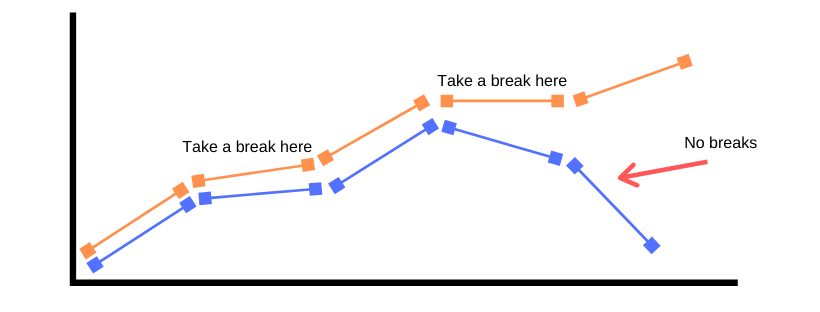
If you don’t take a break, eventually you’ll lose focus and energy, ultimately decreasing workflow.
On the flip-side, if you take a break while your productivity is high, you refresh the brain and continue with that energy when you return.
It doesn’t have to be overly complicated, either.
Eating, reading, or any other low-grade activity is perfect as a break.
12. Make an outline of your copy
I was recently on my friend Zach’s podcast over at Profitable Ads. (Check him out if you need PPC management ;))
On the episode, he asked me what my best copywriting tip is for everyone listening.
I told him that the most important thing you can do is make an outline of everything you write.
Include the major points, subpoints, and references in bullet points. It’s that simple.
This prevents you from having to stare at a blank white screen until you go blind.
You instantly know what you’re writing about, giving you Superman-like confidence and the writing speed up of a cheetah.
Try it today and you’ll see how insanely effective it is.
13. Collaborate with team members
I remember one of my previous copywriting clients was an advertising agency that managed over $1 billion in ad spend.
When we began working together, I had to interview their team along with Google product leads they partnered with. How cool is that?
I realized the importance of speaking with internal people at companies you’re working with ever since then.
They’re experts about the product after all, right? So, it only makes sense to ask them questions and pick their brain.
Afterward I felt like the Einstein of their product and business, helping me write that much better content for them.
You should do the same.
Brainstorm who you can speak to within your own company or a client’s to learn more about what you’re writing about.
Because if you’re a copywriter for hire like me, you often throw into the mix.
It’s chaotic. You have to be quick on your feet. You have to learn fast.
Leverage other people’s knowledge to save time and energy during your next UX copywriting project.
Wrapping up UX writing best practices
UX writing is one of the most enjoyable and impactful forms of copywriting there is.
You single-handedly have an impact on how users will interact with a product, app, etc.
But like all forms of writing, it can get hectic.
Deadlines, meetings, and information can pile up above your head.
That’s why you want to make sure to use some of the best practices for UX writing I outlined today during your next project.
They will improve your workflow, productivity, and enhance the end product.
What was your favorite tip from today?














